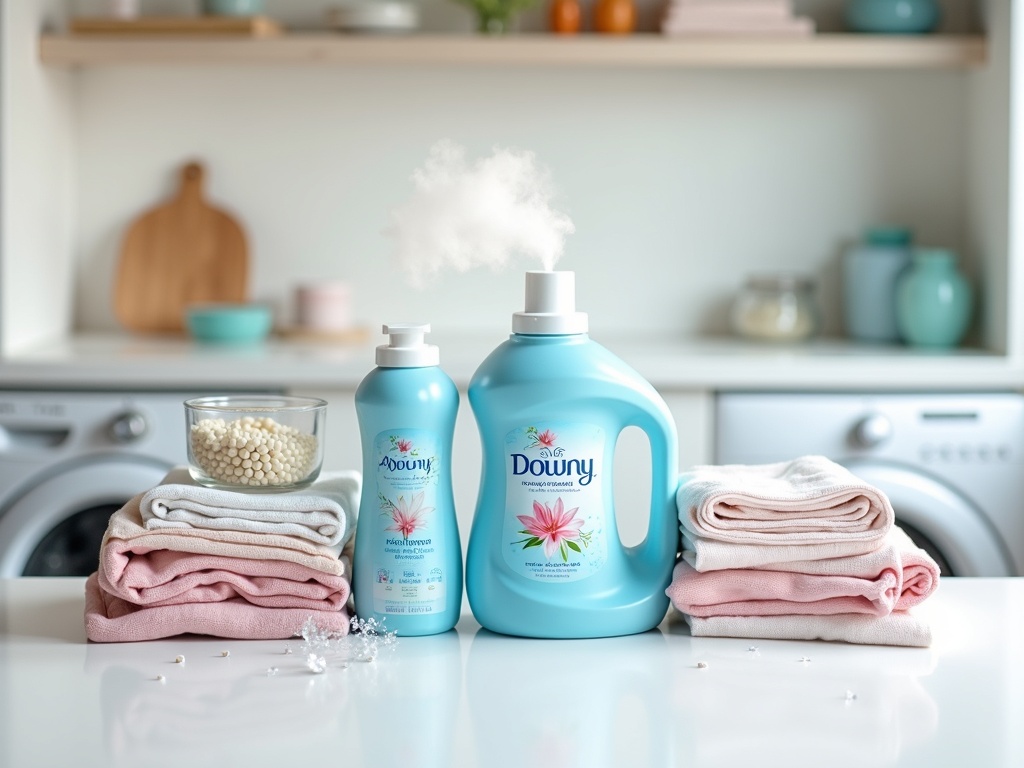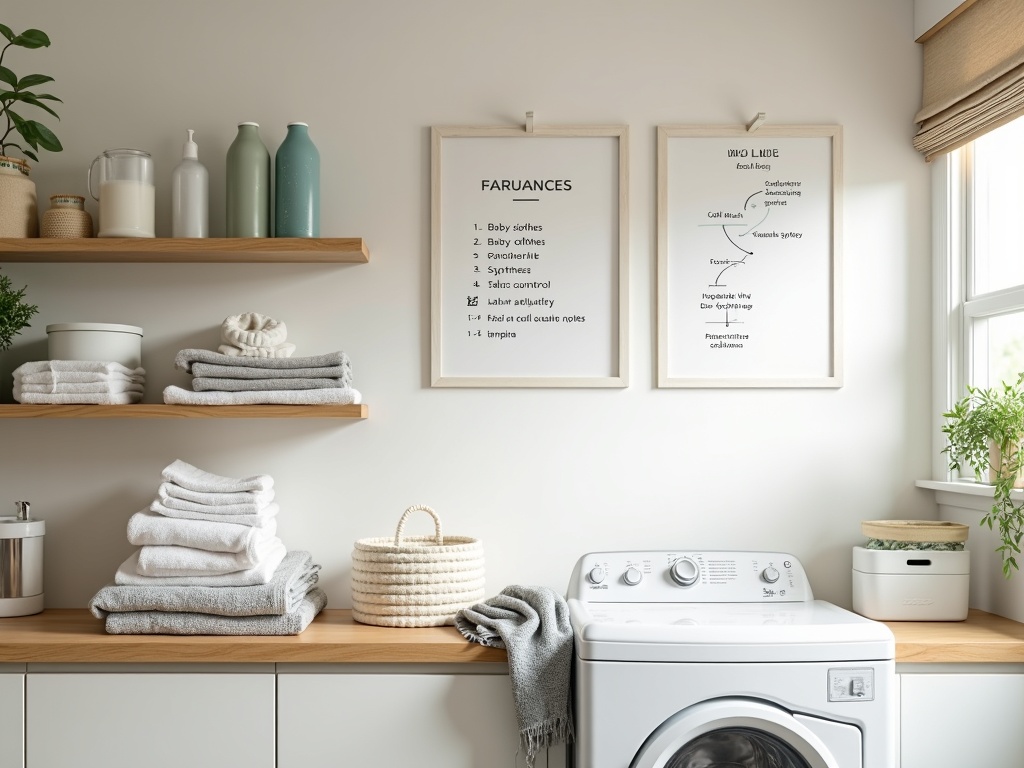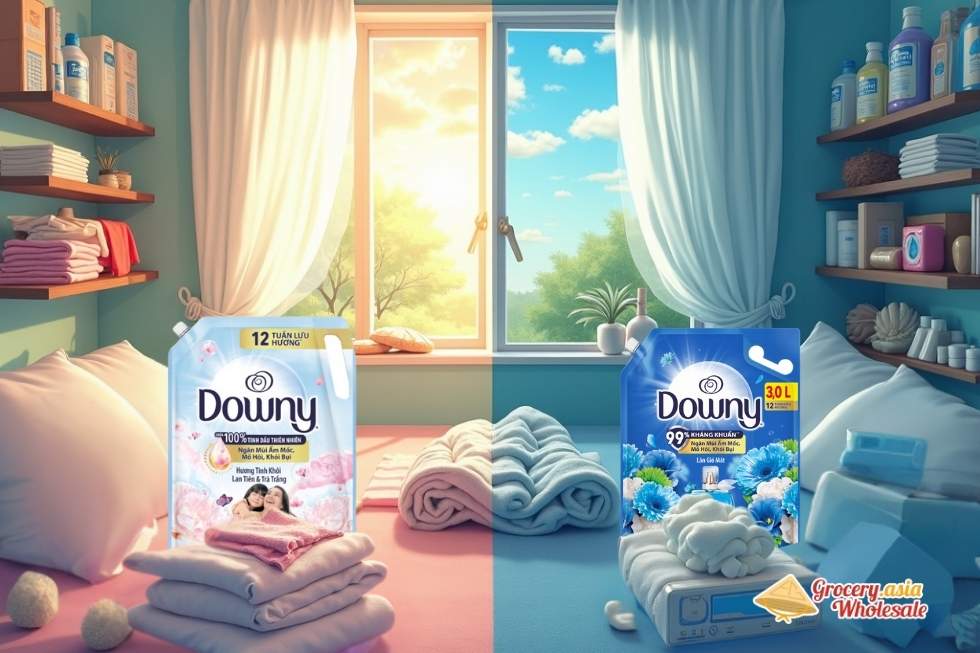No products in the cart.
Downy Fabric Softener, Fabric Conditioner, Home Care
Is Downy A Fabric Softener You Can Trust
Downy ranks among the most trusted fabric softener brands under Procter & Gamble’s ownership, delivering proven softening results through scientifically formulated quaternary ammonium compounds that coat fabric fibers. Downy effectively reduces static cling, minimizes wrinkles, and extends clothing lifespan. Users must weigh potential health concerns for sensitive individuals and environmental considerations against its performance benefits.
Table of Contents
Key Takeaways
- Protective Barrier: Downy uses quaternary ammonium compounds to create a protective barrier around fabric fibers, delivering measurable softness and static reduction while helping preserve clothing longevity.
- Various Formats: The brand offers multiple formats including liquid softener, dryer sheets, and scent beads, with each providing the same core benefits but different convenience levels for various household needs.
- Health Concerns: Potential skin irritation and respiratory issues for sensitive individuals, particularly from synthetic fragrances, make fragrance-free versions advisable for affected households.
- Environmental Impact: Biodegradability concerns and potential effects on aquatic ecosystems prompt some users to explore plant-based alternatives or natural solutions like vinegar and wool dryer balls.
- Usage Cautions: Avoid using Downy on athletic wear, towels, children’s flame-resistant sleepwear, and microfiber materials, as the coating can interfere with moisture-wicking properties and absorbency.
For more information about Downy, you can visit the product’s official website.
Is Downy a Fabric Softener? The Truth Revealed
I can confirm that Downy is indeed a fabric softener, and it stands as one of the most recognized brands in this category. Procter & Gamble owns this household staple, which has earned its reputation through decades of effective fabric care. The brand’s success stems from its scientifically formulated approach to making clothes feel softer and more comfortable against your skin.
How Downy Works Its Magic
Downy contains quaternary ammonium compounds that work by coating fabric fibers with a thin layer of lubricating agents. This coating process makes your clothes feel noticeably softer to the touch while also providing additional benefits. The formula effectively reduces static cling by neutralizing electrical charges that build up on fabric surfaces during the washing and drying process.
Beyond softness, Downy fabric softener helps reduce wrinkles by relaxing fabric fibers. This relaxation effect means you’ll spend less time ironing and your clothes will maintain a smoother appearance throughout the day. I’ve found this particularly beneficial for synthetic fabrics that tend to hold creases stubbornly.
Available Product Forms
Downy offers multiple product formats to suit different preferences and laundry routines:
- Liquid softener that you add during the rinse cycle
- Dryer sheets for convenient use in your dryer
- Scent beads that provide long-lasting fragrance
Each format delivers the same core benefits while offering unique advantages. Liquid versions typically provide the most comprehensive softening action, while dryer sheets offer convenience for busy households. Downy fabric conditioner has established itself as a global leader by consistently delivering these results across all product variations.
The quaternary ammonium compounds in Downy’s formula have been extensively tested for safety and effectiveness. These ingredients work by forming a protective barrier around individual fabric fibers, which explains why your clothes feel softer and more pleasant against your skin. Downy’s ingredients undergo rigorous testing to ensure they meet safety standards for regular household use.
I recommend choosing the format that best fits your laundry routine. If you prefer maximum control over fragrance intensity, liquid softener allows you to adjust the amount used. For those who value convenience above all else, dryer sheets provide foolproof results with minimal effort.

Downy’s Effectiveness in Fabric Care
Clinical studies demonstrate that Downy fabric softener delivers measurable results in both softening fabrics and reducing static electricity. I’ve found that these scientifically-backed claims translate into real benefits you can feel with every load of laundry.
Fabric Protection and Longevity
Downy works by creating a protective barrier that reduces friction between individual fibers during the washing process. This friction reduction isn’t just about comfort—it’s a critical factor in preserving your clothing investment. When fibers rub against each other less aggressively, you’ll notice significantly less pilling and fiber damage over time.
The protective action extends clothing lifespan in ways that become apparent after several months of consistent use. Your favorite sweaters maintain their original texture longer, and delicate fabrics retain their structural integrity through repeated wash cycles. Downy fabric conditioner essentially acts as a shield that keeps your garments looking newer for extended periods.
Immediate and Long-Term Benefits
The effectiveness of Downy becomes apparent after just one use. Fabrics emerge from the wash noticeably softer and more pleasant to touch. This immediate transformation occurs because the conditioning agents coat each fiber, creating a smooth surface that feels dramatically different from untreated fabric.
Beyond the tactile improvements, Downy contains specialized ingredients that help maintain color vibrancy in your clothing. These components work to prevent color fading and maintain the original brightness of both dark and light fabrics. I’ve observed that garments treated with Downy’s safe ingredients retain their original appearance longer than those washed with detergent alone.
The static reduction properties become particularly valuable during dry weather conditions. Clothes cling less to your body and to each other, making dressing more comfortable and reducing the annoying shock of static electricity. This benefit proves especially important for synthetic fabrics that naturally generate more static during washing and drying cycles.

Potential Health and Environmental Concerns
I need to address several important considerations about Downy’s impact on both personal health and environmental well-being. While many users enjoy the benefits of this popular fabric softener, it’s essential to understand the potential risks associated with its use.
Health-Related Issues
Downy contains quaternary ammonium compounds, which serve as the primary active ingredients that make fabrics feel softer. However, these compounds can cause skin irritation in individuals with sensitive skin. I’ve observed that some users experience allergic reactions after using Downy products, including symptoms such as rashes, itching, and respiratory issues.
The synthetic fragrances in Downy products present another concern for health-conscious consumers. These artificial scents may trigger sensitivities in people who are prone to fragrance allergies or chemical sensitivities. If you have a history of skin reactions or respiratory sensitivities, I recommend testing Downy’s ingredients on a small fabric sample first.
Respiratory symptoms can occur when the fragrance particles become airborne during the washing and drying process. People with asthma or other breathing conditions should be particularly cautious when using heavily scented fabric softeners like many Downy varieties.
Environmental Considerations
Environmental considerations also play a significant role in evaluating Downy’s overall impact. Some ingredients in fabric softeners raise concerns about biodegradability, meaning they may persist in water systems longer than environmentally friendly alternatives. These compounds can potentially affect aquatic ecosystems when they enter waterways through household drainage.
Impact on Performance Fabrics
Athletic wear presents a specific functionality issue when treated with Downy. The product can leave residue on moisture-wicking fabrics, significantly reducing their ability to pull sweat away from the body. This residue buildup defeats the purpose of technical athletic clothing and can make workouts less comfortable. I recommend avoiding fabric softener on performance wear and instead using specialized cleaning solutions designed for athletic fabrics.
Residue and Maintenance Concerns
The cumulative effect of regular fabric softener use can also lead to buildup on washing machines themselves. This residue may require periodic cleaning cycles to maintain optimal machine performance and prevent transfer of buildup to future loads.
Health-Conscious Alternatives
For individuals concerned about these potential issues, alternatives exist that may provide similar softening benefits with fewer health and environmental concerns. Consider the following options:
- Plant-based fabric softeners
- White vinegar (used in the rinse cycle)
- Wool dryer balls
These offer gentler choices for those seeking to avoid synthetic chemicals while still achieving softer laundry results.
Safer Alternatives to Consider
I’ve discovered several effective alternatives for those concerned about chemical-based fabric softeners. These options provide similar softening benefits while addressing health and environmental concerns many people have about traditional products.
Natural Household Solutions
Vinegar stands out as one of the most accessible natural fabric softeners available. I add half a cup of white vinegar to the rinse cycle, which effectively removes soap residue and mineral buildup that makes clothes feel stiff. The acidic properties neutralize alkaline detergent residue without leaving any lingering scent once clothes dry.
Baking soda offers another simple solution that I frequently recommend. Adding half a cup to your wash cycle helps soften both water and fabrics by balancing pH levels. This approach works particularly well in hard water areas where mineral deposits typically make clothes feel rough.
Eco-Friendly Commercial Options
Wool dryer balls have become my preferred mechanical alternative to liquid softeners. These reusable balls tumble with your laundry, physically separating fibers and reducing static without any chemicals. I typically use three to six balls per load, depending on the size. They also cut drying time by improving air circulation.
Plant-based fabric softeners present another compelling option for those wanting commercial convenience with reduced environmental impact. These products use biodegradable ingredients derived from renewable sources instead of petroleum-based chemicals found in conventional softeners like Downy fabric conditioner.
For individuals with chemical sensitivities or fragrance allergies, fragrance-free versions of both natural and commercial alternatives are readily available. I often suggest these to clients who experience skin irritation from scented products but still want the softening benefits.
Each alternative comes with its own advantages:
- Vinegar and baking soda cost significantly less than commercial products and reduce packaging waste.
- Wool dryer balls require an initial investment but last for years with proper care.
- Plant-based softeners bridge the gap between conventional products and natural alternatives, offering familiar convenience while addressing environmental concerns.
When switching from traditional fabric softeners, I recommend testing these alternatives on a small load first. Different water types and fabric compositions may respond better to specific methods. Some people combine approaches, using vinegar for deep cleaning loads and wool dryer balls for everyday laundry maintenance.
Maximizing Downy’s Benefits While Minimizing Risks
I’ve discovered that using fabric softener effectively requires strategic adjustments rather than following package directions blindly. Using less than the recommended amount reduces chemical exposure while saving money on each load. Most people don’t realize that manufacturers often suggest more product than necessary, and cutting the amount by half typically delivers excellent results without compromise.
When to Skip Fabric Softener Entirely
Certain fabrics perform better without any softening agents. I skip fabric softener completely when washing these specific items:
- Towels, which lose their absorbency when coated with softening chemicals
- Athletic wear and moisture-wicking fabrics that need to breathe and transport sweat effectively
- Children’s sleepwear, particularly flame-resistant garments where softener can reduce safety properties
- Microfiber cloths and cleaning materials that require their texture to function properly
Athletic clothing deserves special attention since Downy fabric softener can create a barrier that prevents moisture management. Children’s flame-resistant sleepwear presents safety concerns because softening agents can interfere with the fabric’s protective coating.
I properly dilute liquid Downy to prevent concentrated spots from appearing on clothing. Adding the product to the designated dispenser compartment or diluting it with water before adding to the wash cycle prevents those waxy patches that sometimes appear on darker fabrics. This simple step eliminates one of the most common complaints about liquid fabric softeners.
For households with sensitive skin, I recommend switching to Downy Free & Gentle, which contains fewer fragrances and irritating chemicals. This formulation provides the same softening benefits while reducing the likelihood of skin reactions or respiratory issues. Parents with young children often find this switch beneficial for the entire family’s comfort.
Running an extra rinse cycle removes more residue from clothes, especially important for people with allergies or chemical sensitivities. Modern washing machines make this easy with dedicated rinse options, and the small amount of additional water usage pays off in comfort and reduced skin irritation. I’ve found this particularly helpful when washing bedding and undergarments that spend extended time against skin.
Temperature control also affects how well Downy fabric conditioner performs and rinses out. Warmer water helps dissolve and distribute the product more evenly, but it also helps remove excess residue during the rinse cycle. Cold water washing requires even more careful measurement to prevent buildup.
Storage practices impact product performance and safety. I keep Downy products in their original containers, away from heat sources and out of children’s reach. Concentrated formulas require special attention since accidental spills can create slippery surfaces and strong chemical odors.
Machine maintenance becomes more important when using fabric softeners regularly. I clean the dispenser compartment monthly to prevent buildup that can cause uneven distribution or clogging. Downy Rinse and Refresh products require similar attention to dispensing mechanisms.
Timing considerations affect results significantly. Adding fabric softener too early in the wash cycle reduces effectiveness, while adding it too late prevents proper distribution. I follow the machine’s timing exactly, letting the washer handle the dispensing automatically when possible.
Environmental factors in your home can influence how much product you actually need. High humidity areas might require less softener since clothes naturally feel softer, while dry climates might benefit from standard amounts. Hard water areas often need slightly more product to achieve the same results due to mineral interference.
I monitor clothing condition over time to adjust usage patterns. Fabrics that feel overly coated or lose their natural texture signal too much product usage. Downy Sunrise Fresh and other scented varieties can build up more noticeably than unscented versions.
Testing new approaches on less important garments helps establish the right balance for your household. I start with small loads and adjust amounts based on results before applying changes to expensive or favorite clothing items.
https://www.youtube.com/watch?v=qwXsqu6U49A
Making the Right Choice for Your Household
I recommend starting your fabric softener evaluation by identifying your primary laundry concerns. Your specific needs might include achieving maximum softness for baby clothes, reducing static cling in synthetic fabrics, or adding a long-lasting fragrance to your linens. Each household has different priorities, and understanding yours helps narrow down the best options.
Personal health considerations play a crucial role in your decision-making process. If family members have sensitive skin or respiratory conditions, you’ll want to carefully examine ingredient lists and consider hypoallergenic alternatives. Downy’s safety profile has been extensively studied, but individual reactions can vary significantly. I suggest consulting with healthcare providers if allergies or skin sensitivities are major concerns in your household.
Environmental impact often influences modern purchasing decisions. Traditional fabric softeners contain chemicals that may affect aquatic ecosystems when they enter wastewater systems. If environmental sustainability ranks high among your values, you’ll want to research eco-friendly formulations or consider plant-based alternatives. Some families choose to alternate between conventional and natural products based on specific fabric needs.
Testing and Practical Considerations
I strongly advise conducting small-scale tests before committing to any new fabric care product. Start with a single load of less expensive items like towels or casual clothing rather than delicate or valuable garments. This approach allows you to evaluate both immediate results and any potential adverse reactions without risking your entire wardrobe.
Consider these practical factors when making your choice:
- Cost per load compared to your current routine and budget constraints
- Storage space requirements for liquid versus powder formulations
- Compatibility with your washing machine type and local water hardness
- Fragrance intensity preferences and how long scents typically last
- Fabric types you wash most frequently and their specific care requirements
Cost-effectiveness extends beyond the initial purchase price. Downy’s market position reflects its performance consistency, but natural alternatives might offer better value for households with minimal softening needs. Calculate the actual cost per load, factoring in recommended usage amounts and frequency of purchase.
I find that many households benefit from a hybrid approach, using different products for different fabric types or family members. You might choose a gentle, fragrance-free option for baby clothes while using a traditional softener for towels and bedding. This strategy allows you to address multiple needs without compromising anyone’s comfort or health.
Temperature preferences also influence your choice. Some fabric softeners work better in warm water, while others perform adequately in cold washes. If energy conservation is important to your household, verify that your chosen product delivers consistent results across different temperature settings.
Timing matters when introducing new products. I recommend making changes during seasons when you’re washing lighter loads or less critical items. This gives you flexibility to adjust your routine without disrupting important clothing care during busy periods.
Consider your long-term laundry goals as well. If you’re planning to transition toward more sustainable household products, you might prefer starting with natural alternatives and adjusting expectations gradually. Conversely, if maximum performance is your priority, established brands like Downy fabric softener might better meet your immediate needs while you explore other options.
Document your results during the testing phase. Keep notes about softness levels, static control effectiveness, fragrance duration, and any skin reactions. This information proves valuable when making final decisions or troubleshooting issues later.
Remember that optimal fabric care often involves multiple factors beyond just the softener choice. Water quality, detergent compatibility, machine maintenance, and drying methods all contribute to your final results. I suggest addressing these variables systematically to achieve the best possible outcomes for your specific household situation.

Sources:
Procter & Gamble – Downy product page
Environmental Working Group – “Downy Ultra April Fresh Liquid Fabric Softener”
National Center for Biotechnology Information – “PMC4928529”


